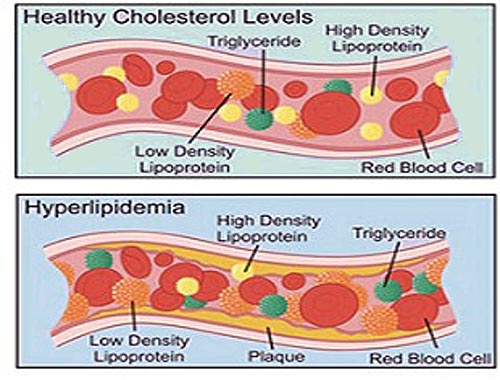Hyperlipidemia, Dyslipidemia

Published: 18 Jun 2025
ICD9: 272.4 ICD10: E78.4 ICD11: 5C80.Z
Hyperlipidemia and Dyslipidemia are often used interchangeably to describe abnormal levels of lipids (fats) in the blood.
While closely related, there's a subtle distinction:
![]() Hyperlipidemia: Literally means "high lipids." It refers specifically to elevated levels of any or all lipids in the blood. This primarily includes cholesterol (total cholesterol, LDL cholesterol "bad" cholesterol, and triglycerides. A common example is hypercholesterolemia, meaning high cholesterol.
Hyperlipidemia: Literally means "high lipids." It refers specifically to elevated levels of any or all lipids in the blood. This primarily includes cholesterol (total cholesterol, LDL cholesterol "bad" cholesterol, and triglycerides. A common example is hypercholesterolemia, meaning high cholesterol.
![]() Dyslipidemia: Refers to an *imbalance* of lipids in the blood. This can include:
Dyslipidemia: Refers to an *imbalance* of lipids in the blood. This can include:![]()

![]() High total cholesterol
High total cholesterol![]()

![]() High LDL cholesterol (bad cholesterol)
High LDL cholesterol (bad cholesterol)![]()

![]() Low HDL cholesterol (good cholesterol)
Low HDL cholesterol (good cholesterol)![]()

![]() High triglycerides
High triglycerides
In simpler terms:
Think of lipids as ingredients in a recipe.
![]() Hyperlipidemia: You have too much of *any* or *all* the fat ingredients (like too much butter, oil, or shortening).
Hyperlipidemia: You have too much of *any* or *all* the fat ingredients (like too much butter, oil, or shortening).
![]() Dyslipidemia: The proportions of fat ingredients are off (like too much butter and not enough oil, or the recipe doesn't work well with the proportions).
Dyslipidemia: The proportions of fat ingredients are off (like too much butter and not enough oil, or the recipe doesn't work well with the proportions).
Key Differences summarized:
| Feature | Hyperlipidemia | Dyslipidemia |
|-----------------|------------------------------|-----------------------------|
| Definition | Elevated lipid levels | Imbalanced lipid levels |
| Focus | Quantity (too much) | Proportions and types |
| Common Use | Sometimes used more broadly, especially if only one lipid is high. | More precise for when multiple lipid levels are abnormal, especially if HDL is low. |
Why are these conditions important?
Both hyperlipidemia and dyslipidemia increase the risk of:
![]() Atherosclerosis: The buildup of plaque (fatty deposits) inside the arteries.
Atherosclerosis: The buildup of plaque (fatty deposits) inside the arteries.
![]() Heart disease: Including coronary artery disease, heart attack, and stroke.
Heart disease: Including coronary artery disease, heart attack, and stroke.
![]() Peripheral artery disease: Reduced blood flow to the limbs.
Peripheral artery disease: Reduced blood flow to the limbs.
![]() Stroke
Stroke
![]() Other conditions: Pancreatitis (especially with very high triglycerides).
Other conditions: Pancreatitis (especially with very high triglycerides).
Causes:
![]() Lifestyle:
Lifestyle:![]()

![]() Unhealthy diet (high in saturated and trans fats, cholesterol, and refined carbohydrates)
Unhealthy diet (high in saturated and trans fats, cholesterol, and refined carbohydrates)![]()

![]() Lack of physical activity
Lack of physical activity![]()

![]() Obesity
Obesity![]()

![]() Smoking
Smoking![]()

![]() Excessive alcohol consumption
Excessive alcohol consumption
![]() Genetics: Family history of high cholesterol or heart disease
Genetics: Family history of high cholesterol or heart disease
![]() Medical conditions:
Medical conditions:![]()

![]() Diabetes
Diabetes![]()

![]() Hypothyroidism
Hypothyroidism![]()

![]() Kidney disease
Kidney disease![]()

![]() Liver disease
Liver disease![]()

![]() Polycystic ovary syndrome (PCOS)
Polycystic ovary syndrome (PCOS)
![]() Medications: Some medications can raise lipid levels.
Medications: Some medications can raise lipid levels.
Diagnosis:
A simple blood test called a lipid panel or lipid profile is used to measure:
![]() Total cholesterol
Total cholesterol
![]() LDL cholesterol
LDL cholesterol
![]() HDL cholesterol
HDL cholesterol
![]() Triglycerides
Triglycerides
Treatment:
Treatment typically involves a combination of:
![]() Lifestyle changes:
Lifestyle changes:![]()

![]() Dietary modifications (heart-healthy diet)
Dietary modifications (heart-healthy diet)![]()

![]() Regular physical activity
Regular physical activity![]()

![]() Weight management
Weight management![]()

![]() Smoking cessation
Smoking cessation![]()

![]() Limiting alcohol consumption
Limiting alcohol consumption
![]() Medications:
Medications:![]()

![]() Statins (the most common type of cholesterol-lowering medication)
Statins (the most common type of cholesterol-lowering medication)![]()

![]() Other medications, such as:
Other medications, such as:![]()

![]() Ezetimibe
Ezetimibe![]()

![]() Bile acid sequestrants
Bile acid sequestrants![]()

![]() PCSK9 inhibitors
PCSK9 inhibitors![]()

![]() Fibrates (primarily used to lower triglycerides)
Fibrates (primarily used to lower triglycerides)![]()

![]() Omega-3 fatty acids (prescription-strength for high triglycerides)
Omega-3 fatty acids (prescription-strength for high triglycerides)
Important Note: It is crucial to consult with a healthcare professional for diagnosis and treatment of hyperlipidemia or dyslipidemia. They can assess your individual risk factors, determine the appropriate treatment plan, and monitor your progress. Self-treating can be dangerous.